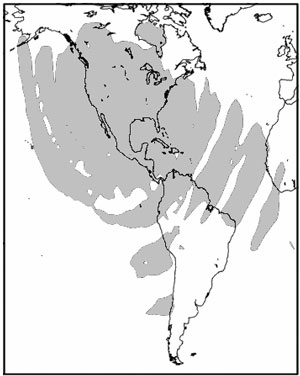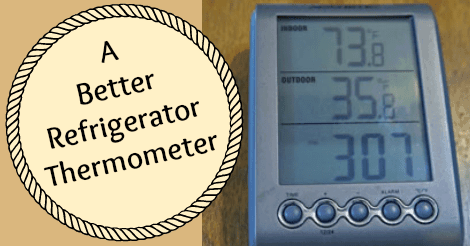A while back I wrote about refrigeration problems and that what seems like a refrigeration problem may actually be a battery problem.
Cruisers Jim and Barbara Shell left a comment on that post that one of the simplest things you can do to know how the refrigerator is doing is to have a thermometer in it. But instead of one of the ones marketed as a “refrigerator thermometer” where you have to open the refrigerator to check the temp, they recommended one with a wireless remote sensor, typically called an indoor/outdoor thermometer.
Another duh moment for me. We’ve had a thermometer with a wireless remote sensor for some time — I’d just never thought to use it in the refrig. And on Que Tal, we’d used an indoor/outdoor thermometer with a wired remote sensor (wireless weren’t reliable when I bought it 10 years ago) to monitor the temperature in the battery compartment.
Before writing about it here, I did some testing with the wireless one to make sure it’d work in the refrigerator. Yep, it’s perfect! Mine even works in a typical home refrigerator where the signal has to pass through the metal “box.”
A couple of notes and then links to thermometers I like. First, it seems that humidity sensors often give incorrect readings unless you buy very high end units. Since this typically adds $10 or more to the cost, why bother? The ones with barometers also tend to get poor marks unless you buy an expensive one.
Second, if you use lithium batteries in both the base unit and the remote sensor, you should get at least a year before having to change batteries. I’ve only changed the batteries once in using mine over four years.
The “indoor” temp on the display means the temp right where the base unit is. If you mount it in direct sunlight, you can get some amazing readings if you’re in a hot climate. Ours was on teak (which soaked up heat) in the companionway (full sun) and I once saw it hit 128° F.! “Outdoor” refers to wherever you put the remote unit.
Some indoor/outdoor thermometers have an “ice alert” that flashes or beeps. The ones that flash (using an LED) aren’t bad, but you really don’t want one that beeps if you’re going to use it in the refrigerator or freezer, as the ice alert will start sounding at about 38° F — in other words, constantly if the refrigerator is working properly. Not only it is annoying but it eats through batteries!
Command Strips work really well to mount both the base unit and remote sensor (don’t put it where it could end up sitting in water or where you’re likely to knock it loose). If you’re not familiar with these, read my article on them — I love them for securely mounting all sorts of things without making holes!
Finally, some units can have multiple remote sensors (sold separately, of course). So you could have separate ones for the refrigerator and freezer, or in the refrigerator and battery compartment, in addition to the “inside” temperature being the temperature wherever you mount the base unit.
Of course, the unit that I have is now “out of stock” — since it may become available again, you can view it here (Amazon US only). Should you get this one, be sure to read the review I left on Amazon to learn a few things about how it works that aren’t mentioned in the user’s guide.
So my alternate recommendations are (basic links are to Amazon US, Amazon Canada/UK shown where available) —
- Acu-Rite Wireless Indoor/Outdoor Thermometer. Simple basic unit that shows indoor and outdoor only — no additional info or extra remotes. Older reviews show problems with battery life but newer ones are much better. I’ve had two Acu-Rite units (the one shown in the photo at the top of this article and the wired one we had on Que Tal) and both have worked well, with good battery life. Available from Amazon.
- Oregon Scientific Indoor/Outdoor Thermometer (Amazon). This is a good choice if you need to monitor more than one remote location. The basic unit comes with one remote sensor, but you can one or two more and monitor up to three remote locations. My biggest gripe with this unit is that additional remotes cost almost as the base unit and remote, but it does work well. (Update: This products appears to no longer be available. This is a similar unit.
A note about units such as this one that include an atomic clock, which is great if you want really accurate time on the boat. If you’re outside the continental US, see the “official” coverage map from the National Institute of Standards and Technology for the atomic clock radio signal below (although I’ve heard that you can get the signal in most of Alaska and Hawaii, which are outside the coverage map) — there is no way to manually set an atomic clock, so if you’re outside the coverage area, the clock won’t work.

In addition to Amazon, you can buy similar units at many big box stores, including Walmart, and at Radio Shack. But be sure to check recent online reviews (discount any over a year old if newer ones show a different level of satisfaction).
Mount the base unit where you’ll see it easily — for us, it was right above the battery monitor, which we also checked several times a day. And then note what the typical temperature is (see my article, Making Your Mark) so that you’ll see not only big problems but also slow, creeping ones.
Keeping an eye on the temperature means that you may catch and solve a problem before you lose a refrigerator full of food. As Jim and Barbara related, “In 2006 while out cruising, we noticed a rising temperature and were able to replace the blown fuse before any thawing occurred.”

Carolyn Shearlock has lived aboard full-time for 17 years, splitting her time between a Tayana 37 monohull and a Gemini 105 catamaran. She’s cruised over 14,000 miles, from Pacific Mexico and Central America to Florida and the Bahamas, gaining firsthand experience with the joys and challenges of life on the water.
Through The Boat Galley, Carolyn has helped thousands of people explore, prepare for, and enjoy life afloat. She shares her expertise as an instructor at Cruisers University, in leading boating publications, and through her bestselling book, The Boat Galley Cookbook. She is passionate about helping others embark on their liveaboard journey—making life on the water simpler, safer, and more enjoyable.
Simplify meal prep on board with proven strategies for provisioning, maximizing fridge space, and cooking delicious meals aboard your boat.










Al Felker says
We use a wired one on our two small fridges & freezer. Very helpful as you say.
Janet Bessent says
Yep – when we finally got our fridge in, was the first thing my husband got. He ha so much fun checking the temp!
Pete Smalley says
I put on a similar one and it works great!
Christopher Wick says
Great idea it is but do check it with your old thermometer. I used this type of set up in a camper of mine with three sending units. One for outside one for inside and fridge temp. But they all would show 7deg cooler than actuall temp. Suggestion dont buy the cheapest one you can get. Good sail’n to ya’
Lynn Clough says
My husband was worried about the engine overheating so we have three sensors; freezer, fridge and engine compartment.
Behan Gifford says
I love this. It’s a great tip. We took the indoor/outdoor from our house and repurposed it that way on Totem.
Rich Mowery says
Brilliant
The Boat Galley says
Wish I could credit, but it was a reader’s suggestion 🙂
Windsong II says
We have used wireless thermometers on our freezer and fridge since we bought the boat. It has allowed us to see the hysteresis in the mechanical thermostats used in each box. After much playing around the best setting on our fridge thermostat has it turning off at 32* and turning on at 42*. So this year I”ll replace the original thermostats with new electronic thermostats, available from Amazon, they have 12 v models that features a digital set temp readout and they sell for less than $20 each.
Bob
Jim Shell says
Ace Hardware has their Taylor wireless remote thermometers on sale for $14.99 through 11/302014. The ad is for the metropolitan Houston, Texas area.
Steve says
Just purchased an Ambient Weather temperature reading system. Same concept as listed, but multiple sensors (up to 8 remotes), easy to read Master Display and a reasonable cost. Pricing is dependent upon how many sensors you need. I also bought the sensors for the refrig/freezer and now I can monitor both in real time from my helm. No more do I have to open the freezer to check the thermometer. Ambientweather.com.
Dicky says
Just want to say thank you